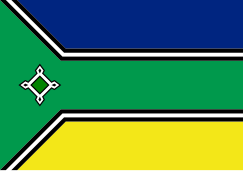Flag of Amapá
This article includes a list of references, related reading, or external links, but its sources remain unclear because it lacks inline citations. (October 2016) |
 | |
| Use | Civil and state flag |
|---|---|
| Proportion | 7:10 |
| Adopted | 5 October 1988 |
| Design | A horizontal tricolor of blue, green with black-edged white lines, and yellow, with a green triangle based on the hoist-side, bearing a stylized outline of the Fortaleza de São José de Macapá in black and white. The green triangle continues as a horizontal stripe to the fly end. |
The current state flag of Amapá was introduced by Decree No. 8 of 23 April 1984.
Symbolism
[edit]Each color has the following meaning:
- The green represents the forests;
- The yellow represents mineral wealth;
- The blue represents the sky;
- The white represents peace;
- Black symbolizes the respect for those who died fighting for the state.
The centralized geometric figure on the hoist-side represents the Fortaleza de São José de Macapá.
Prior to the creation of the Amapá territory, the area was disputed between France and Brazil. Known variously as the Republic of Counani (1886–1887), and the Free State of Counani (1904–1912), these territories were never internationally recognized, and ultimately quelled by the governments of France and Brazil.
The Federal Territory of Amapá established its own flag, which was used after the state's creation on 5 October 1988, and established by Decree No. 8 of 23 April 1984. However, due to disputes at the time, a tripartite version of the state flag of Pará, showing the fort of São José, was popularly used. This version only ceased to be used during the administration of Aníbal Barcelos (pt).
-
 Flag of the Republic of Counani (1886–1887).
Flag of the Republic of Counani (1886–1887). -
 Flag of the Free State of Counani (1887–1904)
Flag of the Free State of Counani (1887–1904) -
 Flag of the Free State of Counani (1904–1912)
Flag of the Free State of Counani (1904–1912)
External links
[edit]- Símbolos do Amapá (in Portuguese)





